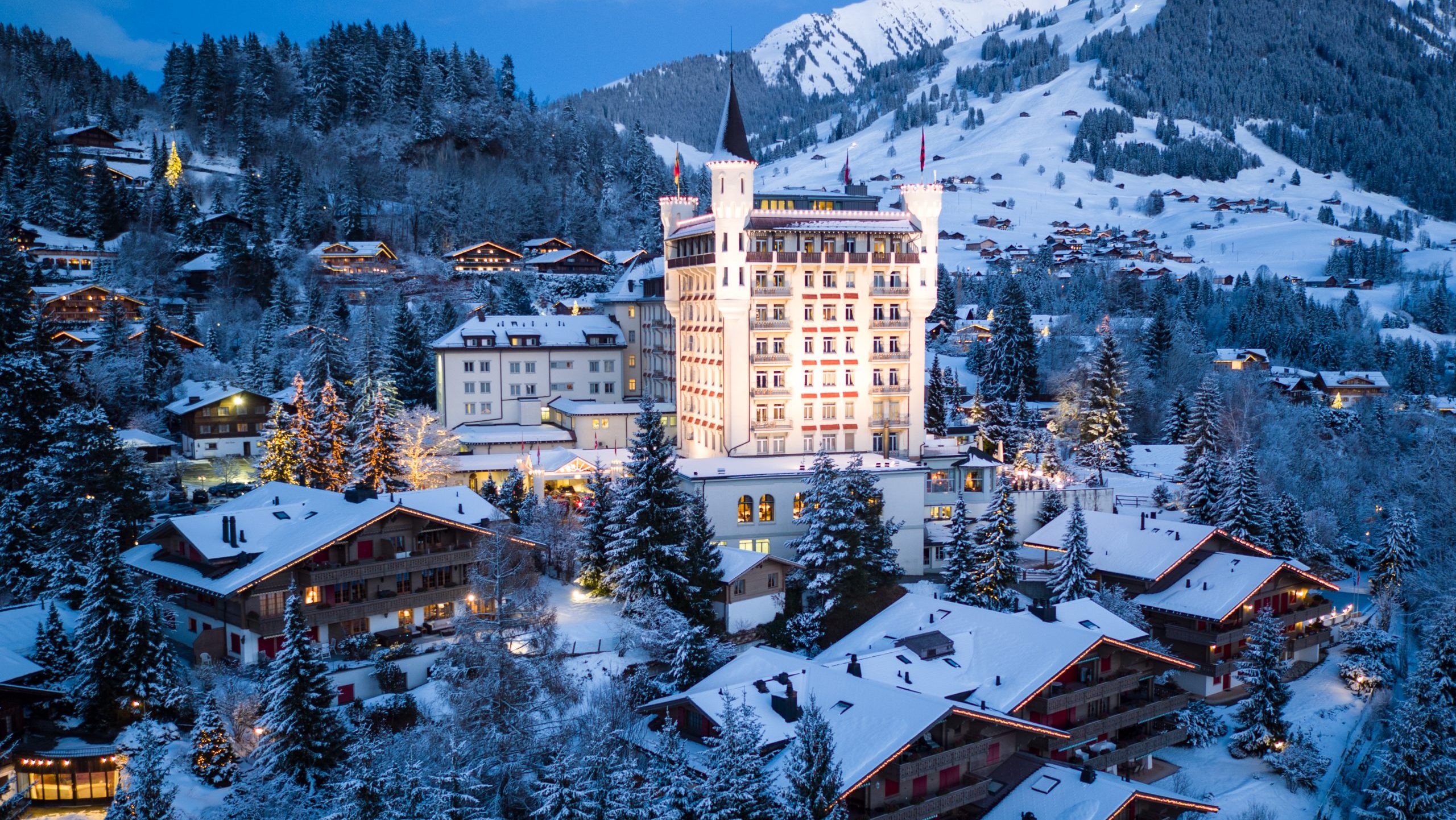
Gstaad, Switzerland
Playground of the Rich and Richer
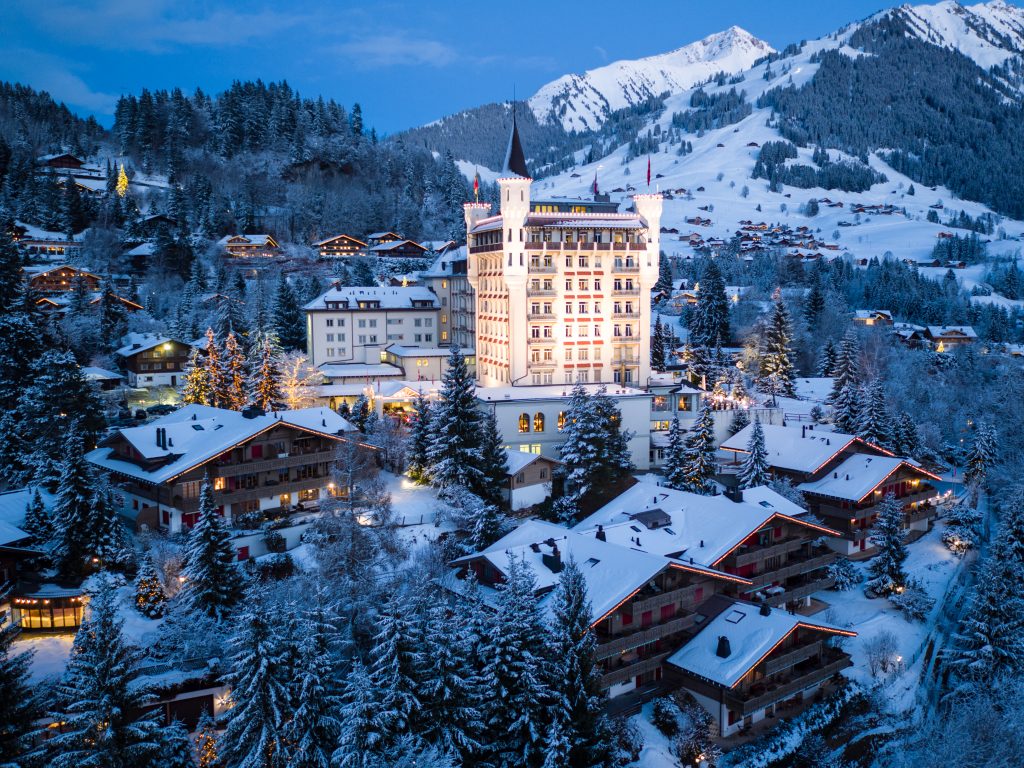
Gstaad, the glamorous ski resort in the Swiss Alps long favored by European society swells, Hollywood stars and fashionistas, is the epitome of chic. Even today, with luxury boutiques lining the streets, the alpine village retains its old-world charm, with centuries-old chalets and horse-drawn carriages toting locals and visitors.
Julie Andrews fell in love with Gstaad on her first visit in 1968, callng it the “last corner of heaven in a crazy world.” She later bought a chalet called “’Fleur de Lys” there, and for many years adorned the town with Christmas lights. She and her husband, Blake Edwards, founded a festival of film music, Cinemusic, in Gstaad in the mid-1990s, and in 2014 Andrews was named an honorary citizen in recognition of her cultural contributions to the region.
Violinist Yehudi Menuhin resided there, and in 1957 founded a music academy and annual music festival that is still in operation today.
Valentino, Princess Grace of Monaco, Liz Taylor, Richard Burton
Many other notable people have owned homes in Gstaad including Grace Kelly and Prince Rainier of Monaco, Peter Sellers, David Niven, Liz Taylor and Richard Burton, and Roger Moore. Fashion designer Valentino Garavani’s swanky Gstaad hideaway, Chalet Gifferhorn, complete with Lalanne sheep sculptures, was featured in the 2008 documentary about his life Valentino: The Last Emperor.
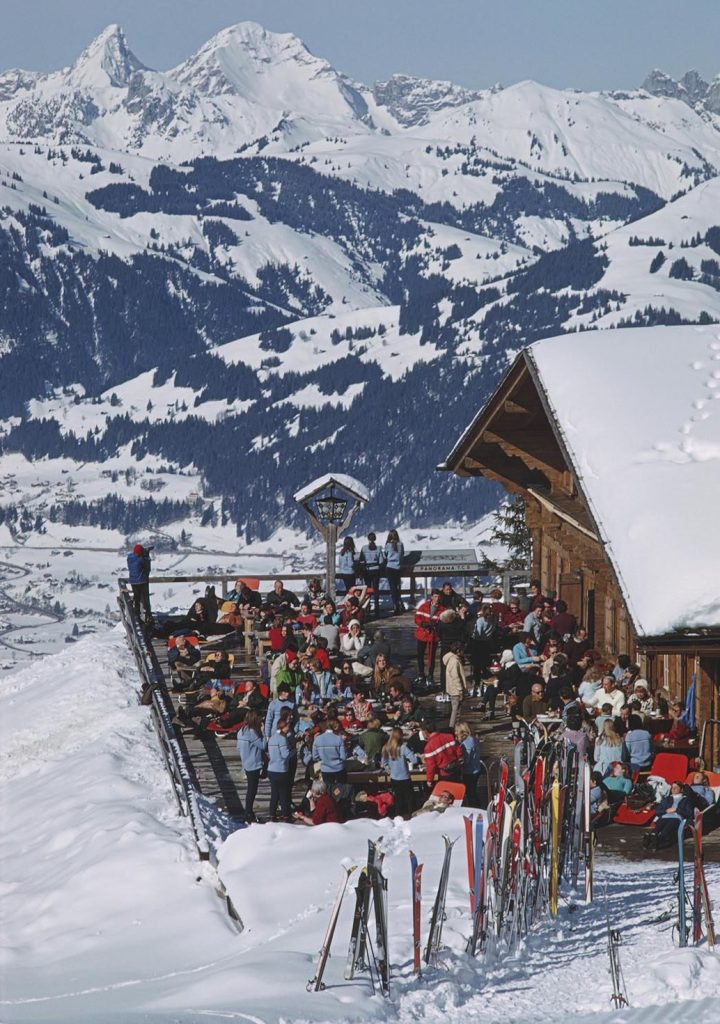
Visitors over the years include the likes of Brigitte Bardot, Gianni Agnelli, Madonna, Leonardo DiCaprio, Tiger Woods and Paris Hilton.
In the center of town a bronze sculpture of a cow – with a tap offering fresh water for passersby – is by the artist Liza Todd-Tivey, the daughter of Elizabeth Taylor and Mike Todd.
Taki Theodoracopulos’s Delicious Snobbery
Slim Aarons loved photographing the comings and goings of the posh folks in Gstaad. Taki Theodoracopulos, the writer who famously chronicles high society with legendary acerbic wit, was an original member of Gstaad’s ultra exclusive, impossible-to-get-into Eagle Club, joining the year of its founding in 1957. Of course, Taki has strong opinions of the nouveaux riche who have colonized Gstaad.
In a 2015 article entitled “What Happened to Gstaad?” in The American Conservative, the magazine Taki co-founded, he complained about what he considers the downward slide of the Eagle’s memership, saying: “After close to 60 years of raising hell and boozing it up in the sun, I am now reduced to keeping out Russians and Arabs, although one or two of the latter have managed to slip by me.” He also took aim at the visitors in town as well: “In Gstaad during the ’50s, ’60s, and ’70s, familiar figures on the slopes were people like William F. Buckley, David Niven, Sir Roger Moore, Henri Cartier Bresson, Dmitri Nabokov, even Lord Menuhin, the great Yehudi. The rot began when Elizabeth Taylor bought a chalet and the paparazzi following her discovered the place. The ensuing publicity made Gstaad and other such resorts the targets of social climbers the world over.”
He lamented the closure of Gstaad’s small indepent stores like cheese shops, butchers and a bookstore. “Fifty years on there are only Cartier, Ralph Lauren, Prada, Chanel, and about three banks. The bookstore was the first to be abolished once people who could count up to a billion but who were illiterate began to frequent the place.” And he griped that the town’s beloved Olden restaurant, run by one family for five generations, was sold to Bernie Ecclestone, “the greedy midget billionaire who runs Formula One.”
Taki also once told a local journalist that he much preferred Gstaad in the 1950s and 60s. “Then, when we were in Switzerland, we acted Swiss. We played by the rules. We didn’t drive fast, or fight, or show off, or break the law. It made Gstaad unique. These pigs that come here now…Europe has given in to money. Once we let it in, there’s no going back.” Upon moving to a new chalet in a more isolated area away from crowds, Taki explained that he couldn’t stand to “hear Ferraris zooming by” his old place any more.
Note that despite his griping Taki hasn’t left Gstaad, so apparently enough of the old money elite remain to keep him there.
The Palace Hotel
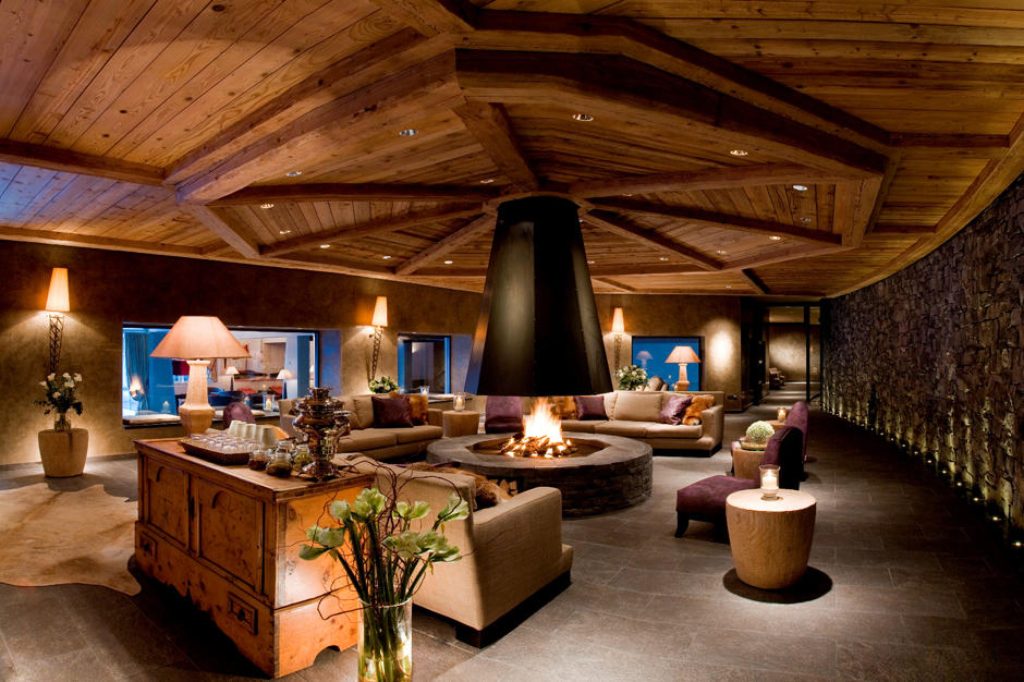
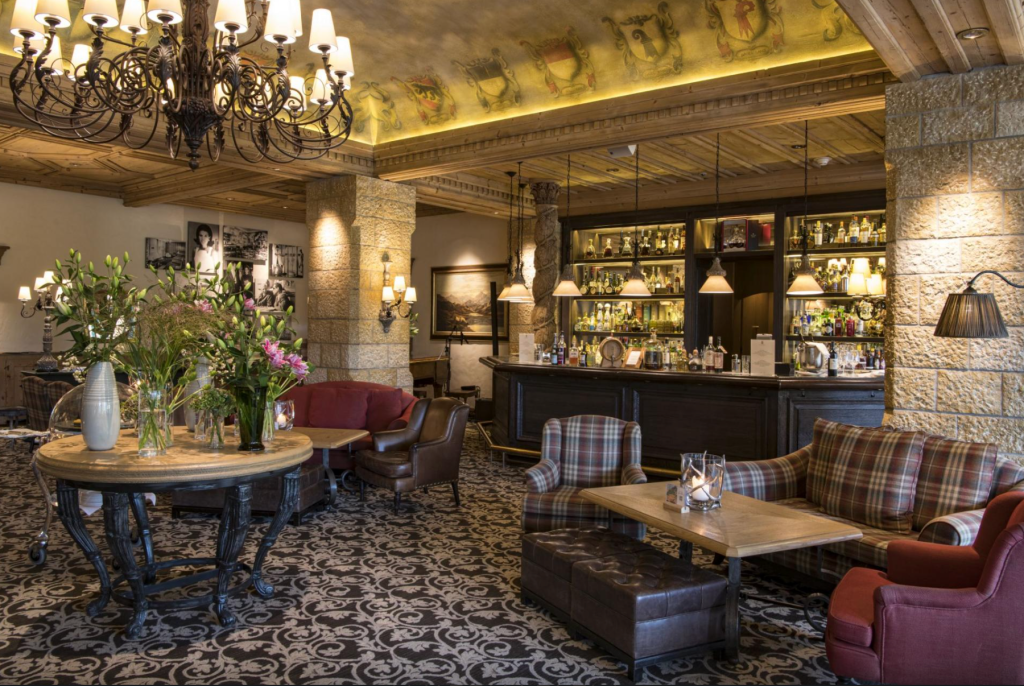
The reason that Gstaad has been able to retain its small-town charm amidst all this glamour is simply local zoning. In 1955, the government declared that all new construction had to adhere to the local chalet style, keeping over-the-top development in check despite the piles of cash homeowners are armed with.

The one exception is the Palace Hotel, which was built in 1913, well before this law was in place. Resembling a turreted fairytale castle atop a hill above the village, the family-owned Palace is considered the center of Gstaad. It oozes elegance – sports jackets are requited at dinner – but in true Gstaad style, it maintains a sense of understated luxury. The ambience, with white-jacketed staff, Venetian chandeliers, and a grand lobby bar, is delightfully unstuffy. And with four restaurants, a huge pool area, ski slopes just outside and even an on-site underground nightclub, guests don’t need to go far to stay entertained here.
However, it’s not remote, you can easily access the village with a short stroll down a wooded path or a quick shuttle ride to the train station. And the views from the rooms and suites are spectacular.
The place is also full of history. British field marshal Bernard Montgomery set up dinner parties here, which he ended promptly at ten o’clock, telling his guests, “Gentlemen, the night was made for sleeping.” In the 1960s, the Palace hotel hosted a gala party with Louis Armstrong and Marlena Dietrich. Prominent guests over the years have included Margaret Thatcher, Kofi Annan, Elton John, Paul McCartney, Diana Ross, Sean Connery, Sophia Loren, Quentin Tarantino, and Jimmy Carter.
Facilities include the fabulous GreenGo club, still with its original 1970s décor, and still stylish, that has hosted the likes of Princess Diana, Tina Turner and Madonna. There’s a health spa with the Palace’s friendly, comfortable atmosphere, featuring a hammam and a lovely circular fireplace. In warmer months guests have access to tennis courts, an Olympic-sized pool and the hotel’s mountain retreat, the Welig Hut.
Dining at the Palace Hotel
Le Grand Restaurant and La Grande Terrasse are the main dining spots at the Palace, serving haute cuisine in a relaxed setting overlooking beatufully manicured gardens amidst mountain peaks. Le Grill, the hotel’s award-winning fine-dining restaurant with a refined yet unpretentious ambience, features international dishes made with fresh local ingredients.
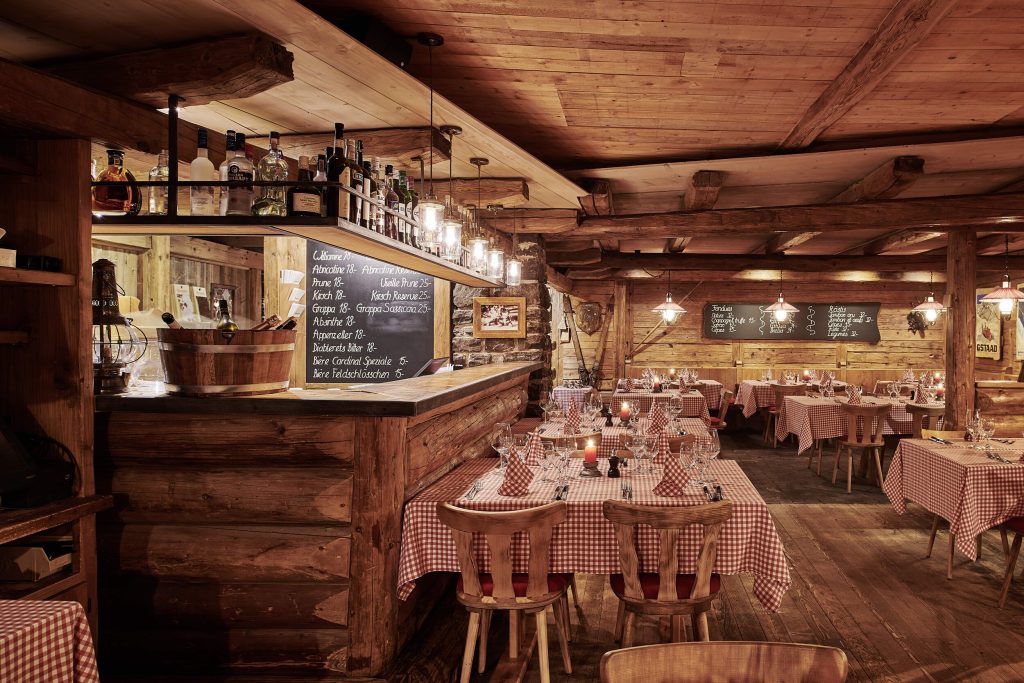
La Fromagerie, a fondue restaurant, is set in a former World War II bunker. Gildo’s, the Palace’s high-end Italian spot, is named for Gildo Bocchini, the hotel’s legendary maître d’ who had welcomed and cooked for guests for nearly 50 years.
The Palace’s Walig Hut makes for a unique private dining experience in a no-frills, 200-year-old alpine hut up in the mountains. A vertigo-inducing drive up into the Alps brings you to the venue situated next to a field of grazing cows, chiming with Switzerland’s trademark cowbells. The Walig Hut’s fare is simple, alpine style comfort food; think veal, potatoes and vegetables. You can even arrange an overnight stay at the hut.
The Alpina Gstaad

Debuting in 2012, the Alpina was the first luxury hotel to open in Gstaad in a hundred years. Given the town’s strict building codes, it took the French and Swiss owners 15 years to complete the six story hotel. And it was well worth the effort. This sophisticated haven with its eco-friendly design, Switzerland’s only Six Senses spa and Michelin-starred restaurants is magical.
The subterranean tunnel entryway feels like a setting in a James Bond film, while the lobby—with its contemporary artwork, double-height ceilings, and sleek central staircase—is clad in reclaimed wood.
The Alpina aspired to be the finest hotel in Switzerland, and the service is exellent, but understated, in true Gstaad style.
The rooms
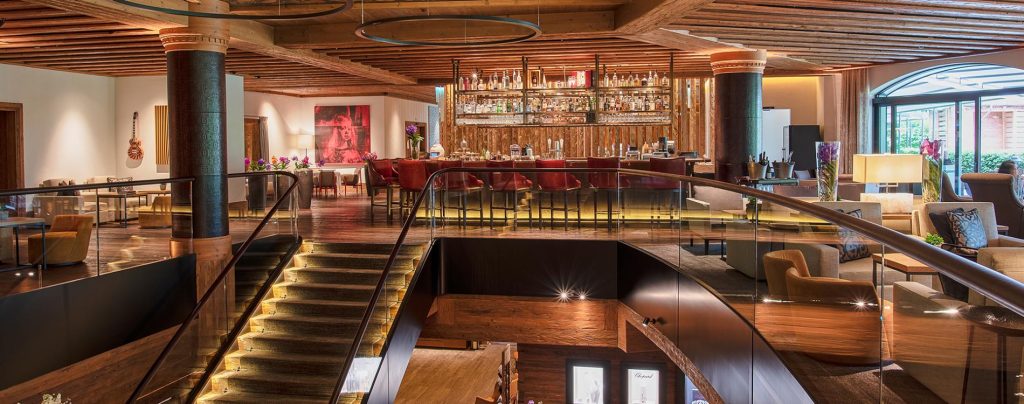
The Alpina’s 56 timber-walled rooms and suites are a mix of contemporary and traditional design. Think abstract paintings, marble bathrooms with large soaking tubs, carved wooden ceilings and lamps made of embroidered leather cowbell straps. Gas fireplaces are a cozy touch as are the warm woolen slippers which you are encouraged to take home.
Dining at Alpina
The Alpina’s five exceptional restaurants are overseen by Michelin-starred executive chef Martin Göschel. Among them is his namesake dining spot, Martin Göschel, which uses Swiss proteins exclusively – all meats, fish and dairy products are local. Also on site is Japanese Megu, where chef Tsutomu Kugota offers sushi, sashimi, and cooked dishes with top-notch ingredients like Kagero wagyu beef. Swiss Monti features sharing style dining with tableside preparation, creative salads, and don’t miss the Swiss cheese cart. The Aplina Lounge and Terrace has classic cuisine for casual lunches and dinners, plus a fine selection of cocktails with gorgeous mountain views.
Breakfast
The Alpina’s breakfast buffet is simply stellar, offered indoors and on the terrace when weather permits. The sumptuous offerings include classics like eggs Florentine, eggs Benedict, golden waffles and pancakes, and fresh baked breads and pastries. There’s a variety of cheeses and cold cuts, plus health-concsious options like meusli, homemade yogurt and fruits. Truly a fabulous morning indulgence.
Six Senses Spa
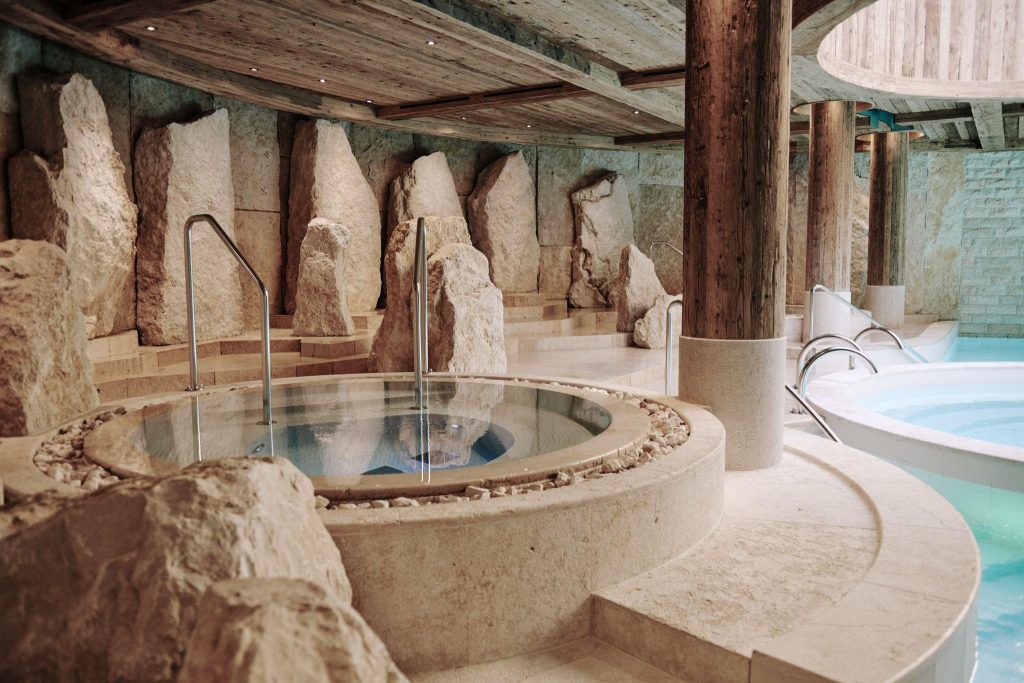
The Alpina’s Six Senses Spa with its salt grotto, main pool, hot tubs, plunge pools and steam caves is divine. At over 20,000 square feet, this luxuirous oasis of calm has a warm, welcoming feel with stone floors and a vast indoor pool bathed in naural light from above. There are separate steam, sauna and hydrotherapy spaces for men and women, plus a heated outdoor pool surrounded by pine trees. The best place to go for post-skiing achy muscles is the outdoor heated pool, where in winter puffs of steam waft into the air.
Treatments on offer include rejuvenating massages ranging from shiatsu to Thai, nourishing facials, body treatments and holistic anti-aging therapies. Try the comprehensive wellness programs which include a Tibetan healing retreat and a three-day yoga-focused sleep retreat to revitalize and restore.
The Chesery Restaurant at Le Grand Bellevue
It came as a great shock to Gstaad’s restaurant scene in 2020 when it was announced that the beloved Chesery was sold and would close after 35 years under chef Robert Speth. Happily, Le Grand Bellevue Hotel snapped up chef Speth to help oversee all of its dining spots, and Chesery’s menu lives on at Leonard’s. The Bellevue’s statement reads, in part: “On behalf of the entire Chesery team, we would like to thank you for your year-long patronage, loyalty, and trust. We look forward to serving you at Le Grand Bellevue… keeping the Chesery’s spirit alive, you will find a variety of its’ traditional dishes in our Leonard’s menu.”
At Leonard’s, nee Chesery, a modern bistro in tones of mint and cream, you’ll find a wide array of sharing plates and dishes including tender beef fillet, risottos and pastas, osso buco, a whole roasted chicken and much more. Leave room for the sumptuous desserts and terrific cheeses.
What to do in Gstaad

Believe it or not, many come to Gstaad for the hotels, food, shopping and people watching. The charming village with its pedestrianized cobblestone streets and flower-bedecked shops is perfect for wandering, popping into shops and sipping hot cocoa. It’s especially magical at Christmas time, and equally delightful in summer.
However, the skiing is superb, so by all means take to the slopes, whether at the top of Eggli or channelling your inner James Bond while slaloming down the Wasserngrat’s Tiger Run. Insider tip: Gstaad’s 120 miles of ski slopes are relatively quiet even in peak season, since many visitors really do come to enjoy everything else the village has to offer. And in summer, Gstaad is equally alluring, bursting with festivals, arts and outdoor activities like hiking, biking and swimming. The hills are alive, as they say.
Arts haven

In February 2025 Simon de Pury, the art dealer and Phillips Auction House owner, declared in his Artnet News column that Gstaad has become the “art world’s ultimate winter playground.” De Pury described his two weeks in the alpine resort as a “nonstop program of cultural happenings, exhibitions, lectures, openings, private dinners, parties, after-parties, and after-after-parties” that forced him to make ultra-tough choices. “I now need a holiday to recover from these holidays,” he quipped.
Gstaad’s reputation as a sleepy village is now a myth, he insisted, adding that “the intensity of Gstaad life these past days could only compare with Miami Beach during Art Basel or New York during the main auction weeks.”
He noted that Gstaad has only in recent years become a hub of artistic activity, and after some softness in the art market, the resort’s wealth makes it prime territory. Gstaad’s glitzier neighbor, St. Moritz, had previously been the center of the art world in the Alps, with dealers like Galerie Gmurzynska, Hauser and Wirth, and Vito Schnabel all opening locations there.
The center of gravity began to move to Gstaad in 2014, he said, with rhe first edition of art show Elevation 1049. In 2025, the Luma Foundation produced the 6th iteration with works of 14 international contemporary artists. In 2018, Larry Gagosian staged his first temporary exhibition in Gstaad, and in 2021 opened a permanent gallery in the center of town. Since 2015, Hauser and Wirth has been using the Gstaad chalet of the late photographer Gunter Sachs as an exhibiton space.
The Maze Art Gstaad show took place for the second time this year, in February. Dealer Joe Nahmad took over a Gstaad venue this winter and tapped Edward Enninful, former British Vogue editor, to curate an exhibition called “Calder in Flight”. Leonardo DiCaprio attended the opening dinner.
Check out more travel stories here.

